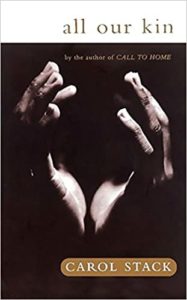Part I: The Household, The Family, and the State

Carol Stack’s All Our Kin is a classic ethnography from the early 1970s. The context for the book was the Moynihan Report on the state of the Black family produced by the U.S. government in 1965. The report’s conclusion was that the Black family was dysfunctional and in disarray. Stack and others explored the validity of that conclusion and examined the question of whether the official data used in the report had missed aspects of the lived lives of Black families, particularly poor ones. Stack’s strategy adopted a radical approach: she engaged in participant-observer research by living in a poor, urban, Black community in the American Midwest, which she refers to as “The Flats.” She spent several years there, integrating herself into the community to the extent possible. This enabled her to see the workings of family structure from the inside in a way not possible when one looks only at the statistical data and similar forms of evidence. The conclusion of All Our Kin is that even though poor Black families were not functioning ideally, they were not nearly as dysfunctional as portrayed in the Moynihan Report.
I first read All Our Kin in the context of teaching about the family. One of the key insights of the book is that we have to disentangle function and form when we analyze the family, as well as other social institutions. Too often we assume that only one kind of form can provide the function we expect from an institution. With the family, we tend to treat the two-parent nuclear family this way. But we also see this with various structures of property rights, as Elinor Ostrom’s work on community responses to commons problems has shown us. If we treat one particular form as a proxy for function, we can miss the creative ways in which humans develop other practices and norms that can perform the same function. Understanding how particular social structures attempt to solve specific problems will require the kind of up close work that Stack did in this book, and that Ostrom did in her research as well. If we base policy on the assumption that there’s only one set of social practices that can solve a particular problem, we are highly likely to overlook the invisible order-generating processes that both Stack and Ostrom observed. Even if these alternative institutions do not perform ideally, they may be the comparatively best option we have, or they may point us in a different direction in the search for changes in policy or other institutions that would improve outcomes. Stack’s book shows that family policy needs to take account of the actual bottom-up sources of social order, particularly in the context of families of color or immigrant families, where histories of poverty, current discrimination, and the legacy of slavery have produced a wider variety of functional family structures.
Stack’s book is of interest to Econlib readers in particular for several reasons. (I have a more extensive treatment of Stack in my chapter “Reciprocity, Calculation, and Non-Market Exchange,” in Commerce and Community: Ecologies of Social Cooperation, Robert F. Garnett Jr., Paul Lewis, and Lenore T. Ealy, eds., New York: Routledge, 2015.) The first reason is that it represents a challenge to the way governments collect data and use them to make policy. In that way, Stack’s book anticipates some of the themes in James Scott’s Seeing Like a State, written three decades later. The Moynihan report approached its subject matter with a framework that was based on a particular view of the family and that wanted to organize what it found in ways that were amenable to public policy, particularly the policies from the era of President Johnson’s Great Society programs. In choosing that approach, it could not see the way people “on the ground” actually organized their family life and how that structure enabled them to respond to poverty and discrimination in reasonably effective ways. All Our Kin is a great story about human adaptability and the importance of bottom-up social coordination, both of which are frequently overlooked by the state.
The specific ways in which families in “The Flats” responded to poverty are also relevant to classical liberals. The Moynihan Report noted the frequency of fatherless families and portrayed them as evidence of the black family’s dysfunctionality. Many non-resident fathers did take on varying degrees of responsibility for their children, but this did not always, or even often, involve legal marriage. Unlike the standard model of the family held up as the ideal by the Moynihan Report, the families of “The Flats” (like other poor families, both historically and globally today) relied on persons outside the nuclear family and physical household to provide income and various forms of household production such as child care. For poor, Black families of this era, the “family” and the “household” were not coterminous in the way they tended to be for white observers.
What observers term as “extended family” was crucial to this adaptability. Mothers relied on their relatives, especially other women, to provide both physical resources and time. In addition, if the father stepped up and took responsibility for his child, even outside of a legal marriage, his extended family was brought into the kin network of the mother and child and could be drawn upon for various kinds of resources. Of additional importance is that the biological mother need not be the de facto mother for purposes of identifying whose extended family will be drawn upon. Motherhood, as well as a variety of other familial relationships, were defined within the community through a long-standing system of evolved norms. Stack argues: “The system of rights and duties should not be confused with the official, written statutory law of the state,” and that these rights and duties are “enforced only by sanctions within the community” (1974, 46). The evolution of norms and the social coordination that results, though pressed upon these families by poverty, are very much a Hayekian spontaneous order process, and one that was hidden from the official view of the state.
Part II coming next week.
*Steven Horwitz is the Distinguished Professor of Free Enterprise and Director of the Institute for the Study of Political Economy in the Department of Economics in the Miller College of Business at Ball State University in Muncie, IN. He is also an Affiliated Senior Scholar at the Mercatus Center in Arlington, VA, a Senior Fellow at the Fraser Institute of Canada, and the economics editor at the Cato Institute’s libertarianism.org. He is the author of four books, including most recently Austrian Economics: An Introduction. He is also the 2020 recipient of the Julian L. Simon Memorial Award from the Competitive Enterprise Institute.
For more articles by Steven Horwitz, see the Archive.


Comments are closed.